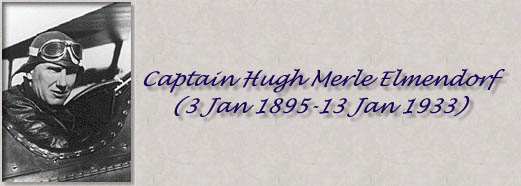Hugh M. Elmendorf, for whom Elmendorf AFB was named, was never assigned to Alaska, nor is there any record of his visiting the Great Land. Yet his presence is felt still throughout the Air Force. He pioneered high altitude formation flying tactics during the 1920s and early 1930s and wrote several scientific papers on the subject. A superb gunner who mastered the fine art of deflection shooting, Hugh Elmendorf won the Army Air Corps gunnery competition at Langley Field in 1927 with the highest score then recorded. He commanded the 19th Pursuit Squadron (currently assigned to Elmendorf and the 3rd Wing) from 1922-1924.
Hugh Elmendorf was born on Elm Street in Ithaca New York on 3 January 1895. He learned the skills of self reliance while obtaining an excellent education. His father, William C. Elmendorf, was a mayor of the city. He attended public school and later, Cornell University, obtaining his Mechanical Engineering Degree in May 1917 less than a month after the United States declared war on Germany. He joined the military almost immediately after graduation in August 1917. He was awarded a regular commission as a second lieutenant of the infantry. He served as an infantry instructor throughout World War I at Camp Greens North Carolina and at Camp Benning, Georgia. He transferred to the Army Air Service only in 1921, receiving his flight training at Carlestrom Field, Arcadia, Florida. He proved to be a natural flyer and received the rating of Pursuit pilot on December 7, 1921. He served subsequently at Ellington Field, Texas, Selfridge Field Michigan, Wheeler Field and Ford Island, Hawaii, Patterson Field, Ohio, and Bolling Field, Washington D.C.
Hugh Elmendorf and First Lieutenant Irvin A. Woodring became entangled in some of the strangest coincidences ever to befall airmen from 1927-1933. On July 14, 1927, the two were involved in a ground collision at Selfridge Field. Woodring was given improper clearance to take off as Elmendorf made his landing in a P-1 pursuit plane. His back broken, Elmendorf remained hospitalized for months at Walter Reed Hospital. Hugh Elmendorf was later returned to flying status, probably inappropriately, in time to set world altitude records at Mather Field, California. While assigned there, he and Woodring engaged in a mock dogfight in honor of the people of Sacremento. Wildly maneuvering, Lt Woodring fell from his aircraft when the seat restraints failed. Successfully deploying his chute just in time, Woodring barely escaped with his life. Later, in January 1933, both Woodring and Elmendorf were assigned by the Air Corps Chief of Staff to test fly the Consolidated Y1P-25 prototype and the ground attack variant, the XA-11.
After a series of test maneuvers in the Y1P-25 on Friday, January 13, 1933, Hugh Elmendorf was seen to slump forward and become unresponsive. His rear seat observer, Captain O. D. “Monk” Hunter managed to escape the doomed aircraft at only 100 feet above the ground. It was felt that the old spinal injury had caused Elmendorf to consciousness or motor control in the high G-forces. Exactly one week later, Woodring joined Elmendorf in death as the XA-11 plummeted to the ground. Both accidents were not attributable to design flaws in the new aircraft which subsequently went into series production as the P-30 and the PB-2.
Hugh Elmendorf, in the slow promotion period of the 1920s and 1930s, attained only the rank of Captain, but his friends and students went on to lead the largest Air Force ever assembled in World War II and he doubtless would have become one of the more important leaders of the U.S. Army Air Forces had he lived. As it was, his friends did not forget his faithful service and selflessness, appealing to congress that the new airfield near Anchorage, Alaska be named in his honor. Hugh Elmendorf was survived by his wife Irene, and young daughter, Virginia. Though he had many relatives, including a brother, Harold, his only direct descendants are named Johnston through his daughter’s married name.
April 12, 1930. Led by Captain Hugh Elmendorf, nineteen pilots of the 95th Pursuit Squadron set an unofficial world record for altitude formation flying over Mather Field, Calif. The P-12 pilots reach 30,000 feet, shattering the old record of 17,000 feet
Michael Robert Patterson was born in Arlington and is the son of a former officer of the US Army. So it was no wonder that sooner or later his interests drew him to American history and especially to American military history. Many of his articles can be found on renowned portals like the New York Times, Washingtonpost or Wikipedia.
Reviewed by: Michael Howard

